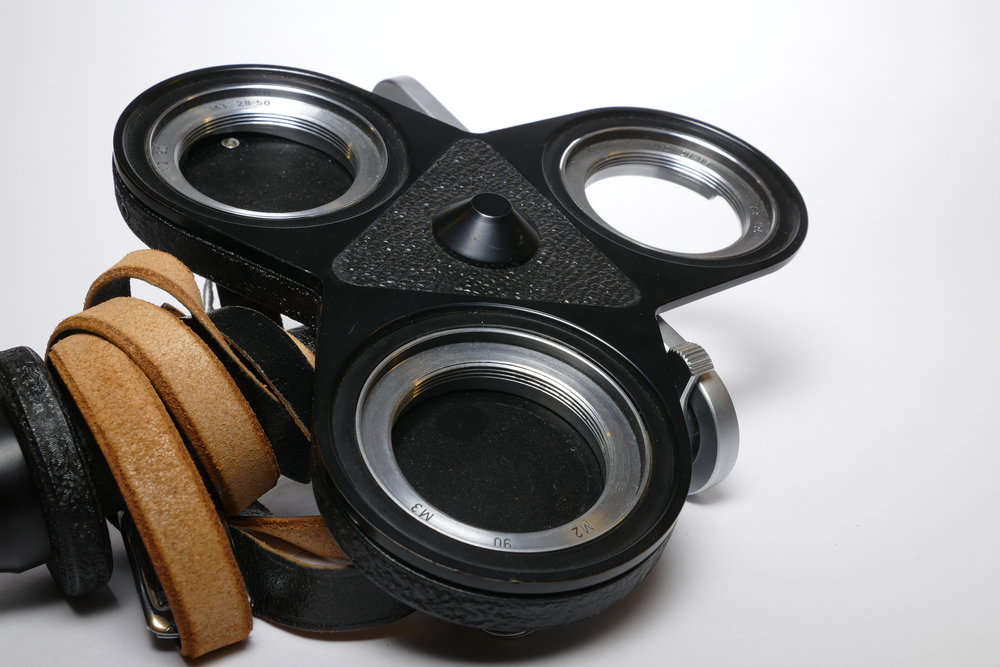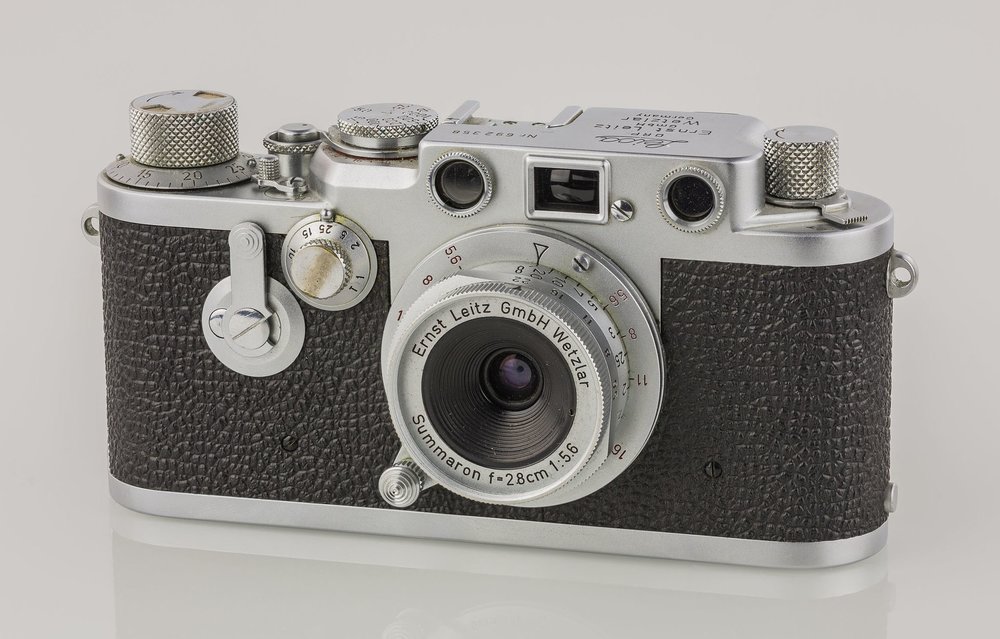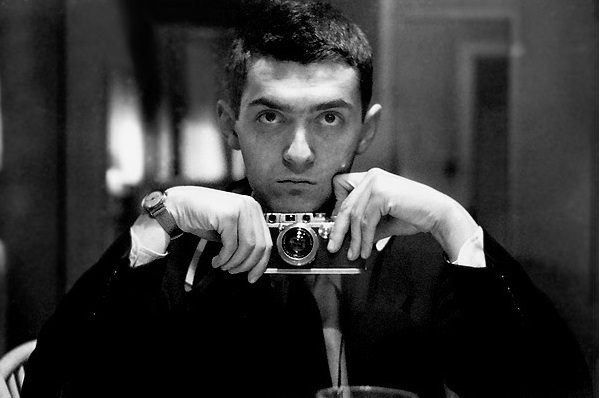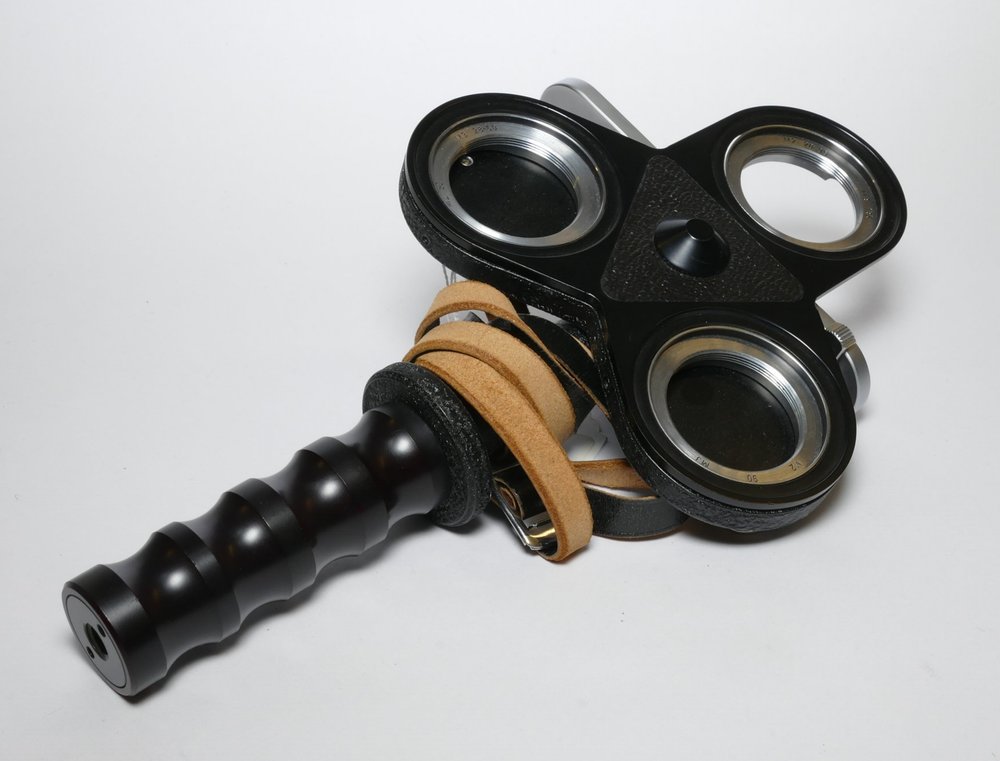Fancy a Tri-Elmar three-focal-length set up for your Leica M? Well, the compact MATE or WATE isn’t your only option. You could have a Leica Lens Turret. Yes, folks, mount three separate lenses on your M, complete with substantial hand grip, and Bob’s your uncle. No one will notice you in the street with this little lot in front of your face.
The lens turret (or OROLF in Leica-speak) flourished for a mere season in 1960, with only 250 examples hitting the shelves. It’s therefore down up there with rocking horse manure in the rarity stakes.

Last week I had the chance to examine a fine example of this amazing accessory at London’s Red Dot Cameras — where it is on sale for £2,000, about £1,200 less than a Tri-Elmar MATE. But you do need three lenses to make it work. And not just any old lenses, read on…..
Gas mask
Looking a bit like a cross between World War I gas mask and a machine-gun turret, the OROLF is a masterpiece of mechanical precision. The camera fits to the contraption by means of a special baseplate. The lens roundabout has a thumbscrew which is a fiendish bit of kit in the way it operates. Turn it to the right and the lens is unlocked from the camera and the turret begins to turn until the next lens is offered up to the mount. A quick flick of the thumbscrew in the opposite direction and the next the lens clicks into the camera and turns to lock. As I found, it is surprisingly quick and accurate and I could well imagine photographers taking to the device with enthusiasm.
There’s one big snag with the Lens Turret, which is possibly a clue to its short life. It flourished for just one year, namely 1960. The clue is that it works only with screw-mount lenses, even though the camera attachment is the standard Leica M bayonet.

Nifty accessory
Why? Simple, really. 1960 was the year when the screw or LTM (Leica Thread Mount) disappeared from the catalogue. The IIIf and IIIg, last of the screw Leicas, had soldiered on for six years after the introduction of the more expensive and swisher M3. So most Leica fans had a stack of screw lenses and, I suppose, the OROLF was seen as a nifty little accessory to carry around.

What most people don’t realise is that even following the introduction of the M3 there remained a strong following for screw-mount cameras, explaining the very existence of the IIIg which was introduced almost three years after the M3. Apart from tried-and-tested familiarity, there were practical reasons for the continued sale of the older models.
The M3 was a more expensive camera and, although the old LTM lenses could be used on the new beast by means of a set of adapters (corresponding to the frameline pairs on the M), there was undoubtedly a temptation to splash out on a bagful of the new M-mount lenses. So, switching over could be an expensive business. But love of the screw-system did come into it. My old friend Don Morley, a budding photo journalist in the 1950s, preferred the Leica IIIf and even found the IIIg, with its large rangefinder window, a step too far. He didn’t at first take to the M3 at all — but he gave in in the end.
The OROLF remains one of Leica’s most unusual accessories and, judging by the unusual price, is in high demand. I rather fancy cutting a dash with one but two grand is indeed a step too far. Instead I’ll put up with my lovely Tri-Elmar MATE.
______________


The top part bears a close resemblance to the children’s spinner device currently causing joy to children and misery to parents world wide.
David
Following your hilarious description of this "thing" in use Mike, the question that pops into my mind is:
Are the people willing to pay £2000 for it, people that regret not buying one during its short period of production, getting in now while prices are still keen, or collectors possessing a keen understanding of the effects of supply and demand and scarcity?
I think we should be told!
But seriously, I suspect that Leitz felt that their customers who had spent years investing in the screw system would feel let down by the introduction of the new system with incompatible lenses and attempted to meet an expected demand, which never came.
It never came because instead of worrying about how to use their screw lenses on the M, many simply went off to buy Nikon SLR cameras.
Your theory could be right. The thing that amazes me is that just when I think I’ve seen every past Leica peccadillo (including the see-round-corners Winkelsucher viewfinder) up pops something even more outlandish.
The spirit of Rube Goldberg…. How did this thing select the correct finder frame for each of the tree positions, or did one have to use the preview lever all the time?
This looks like a device that a vet might use to examine a horse or a blacksmith might use to take stones out of horses hooves. Framelines are not what one would need with this, but rather one of those Russian KMZ turret finders, giving the photographer a ‘two turret’ set up. One might as well go the whole nine yards when using turrets.
William
It’s not that difficult. The screw/M adapters come in sets to match the frame line pairs. So normally you just use the adapter that matches the lens you wish to use. In the case of the Turret the three holes should carry three different adapters so you screw the lenses into the appropriate adapter and the camera then knows which set of frame lines to use. It could be that the adapters can be changed in the Turret but I am not sure.